
33 minute read
Business Profiles
Taking gauging to the next level
Derby based D/Gauge are experts in clearance assessment, with over 40 years’ experience
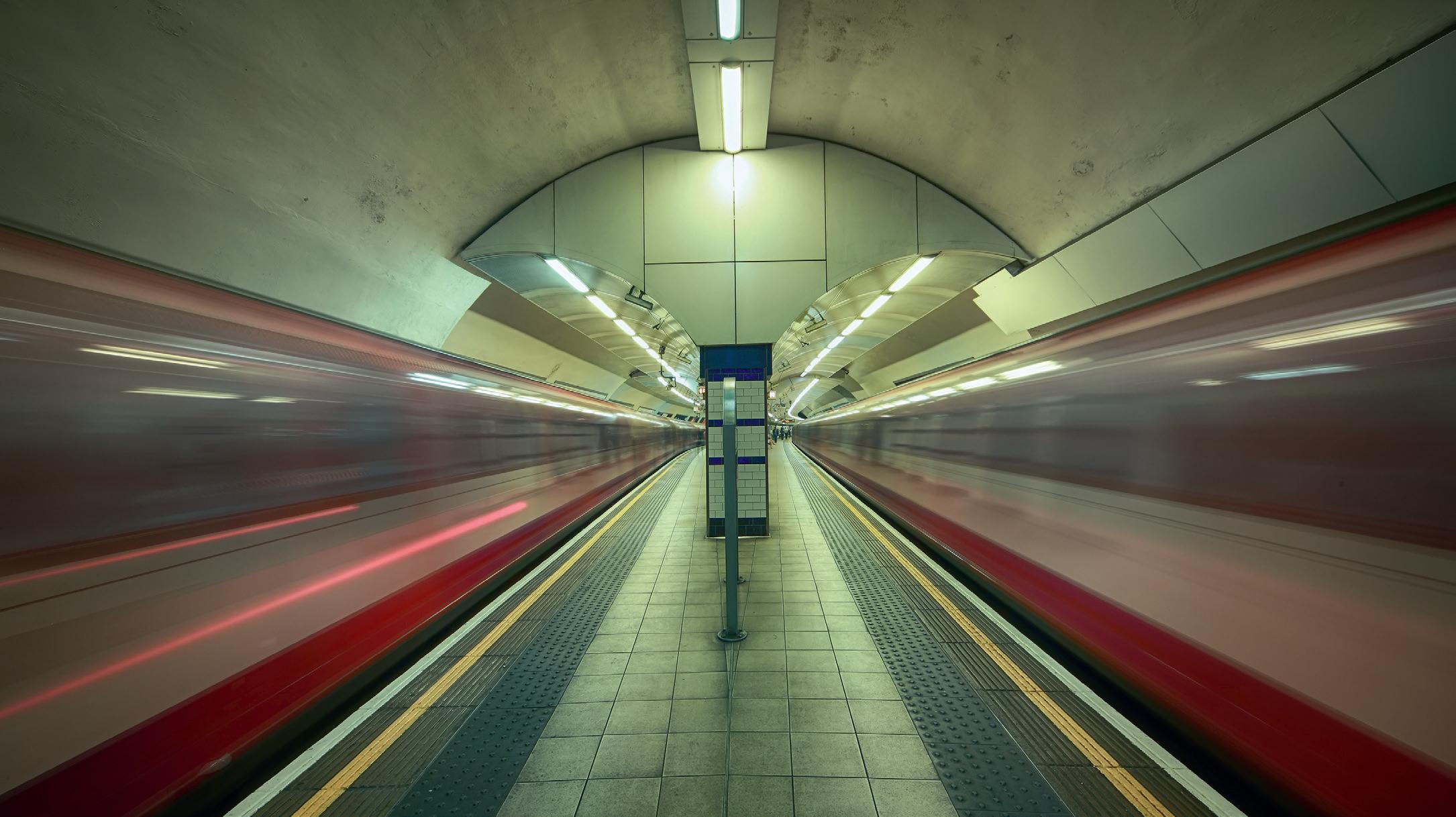
Renowned for extraordinary software and agile consultancy – the team have used the pandemic to launch their new innovative tool. D/Gauge Rift is a brand-new clearance assessment software crafted for Track and Infrastructure Designers.
The next level of gauging 2020 was an exciting year for clearance assessment. The field has made some of its largest technical advancements in a small amount of time. Gauging overall has continued, business-as-usual, helping to get more vehicles on additional routes with safe clearances.
Innovation in rail is at its peak, and SMEs had the opportunity to reinvigorate the supply chain with fresh ideas. D/Gauge is not alone. The rest of the rail industry has seen a collective push towards progression and challenging the status quo. Technologies such as LiDAR scanning coupled with new trainborne techniques for mass data collection, and emerging data analysis through processing tech mean that infrastructure analysis and network clearance data are all improving, and benefit from a better connected, intelligent environment.
D/Gauge have spent the pandemic finalising their new clearance assessment software: D/Gauge Rift. It’s the latest addition to the Track and Infrastructure Engineer’s toolkit. But what exactly is it, and why is it important for the industry? The latest release of clearance assessment software for nearly a decade – gauging engineers and software specialists have combined their skills to create a revolutionary system in an area that could majorly benefit from modernisation.
Why is it important? Gauging is a critical subject. It’s a task which needs to be implemented for a whole number of reasons (such as: network capacity, route opportunity, passenger safety, to name a few). The potential mistakes could be far reaching and the longer it is left, the more painful it could become.
The challenge was to transform gauging from a painful chore (due to improper tools) to an smoother process for Track and Infrastructure Engineers. D/Gauge Rift is removing incumbent shackles and attempting to make gauging more enjoyable! The innovative software will become a key part of the gauging process, rather than a barrier or obstacle.
A connected railway will allow the industry to unlock the UK network’s full potential. D/ Gauge have been working on better mining, analysis, and presentation of data to open new routes and increase usability.
With high aspirations for the industry to deliver future environmental promises: innovation and creativity will pave the way. The collective efforts are important when considering impending targets. Gauging has been given a key role to play in these areas, especially for electrification and decarbonisation with minimal disruption.
The new look of D/Gauge Rift clearance assessment software.

David Johnson, Technical Director of D/ Gauge, was the first person to computerise gauging. He orchestrated the move from poles and wet string to laser scanning and computerised software. His first programme coding led to the conception of VDP Gauging, ITD Gauging and Clear Route (amongst others).
Taking clearance assessment into the future With a strong pedigree of clearance assessment and an outstanding team of engineers, D/Gauge expanded their team to reinforce their software design capabilities. Chunky, slow and confusing – existing gauging assessment software is troublesome for the engineer. Recent technologies have multiplied the volume and accuracy of data that is available, creating a different challenge. The software of tomorrow needs to be able to download, analyse and interpret the increased datasets in an efficient manner.
In recent times we have also seen an increase in the data associated with gauging vehicle models, which also means more data. This, coupled with the ever-increasing volume of data for each slice on the network, means that there is a need to harness as much processing power as possible.
Previously, this would have been limited by the hardware available, but to remove this barrier to speed D/Gauge Rift has been have deliberately built using cloud technology, providing users with all the processing power they require. D/Gauge Rift uses Microsoft Azure servers to provide unrivalled speeds and power, with the added benefit of freeing up the users own computer so that they are able to continue working on other tasks.
Starting from the ground up, D/Gauge has built an entirely new software platform that can manage the increasing demands of our network. It truly is futureproofed. And why? More data enables deeper analysis, quicker decisions and comparative reflection when done correctly.
But what can this state-of-the-art software provide for its end users? For engineers, D/ Gauge Rift provides a simplified approach to gauging. Existing industry knowledge, datasets and standards requirements are all pre-loaded. The software is utilisable by graduate or principal engineer in the same way. The result: teams no longer need to be formally trained in using complex gauging software, and can focus on their exceptional Track and Infrastructure design expertise.
Using innovation to better serve the industry D/Gauge Rift’s inspiration came directly from the market’s needs. There was an ongoing requirement for a tool that can handle gauging but in a more user-friendly way. D/Gauge have been using their own mighty gauging engines for over 15 years, but they require an extreme level of skill and technical knowledge to navigate.
There were also lots of requests to make faster gauging software. In the past decade, various forums have shared the same message. Speed, however, was just one element to unpick. For D/Gauge- speed is not the sole area of focus. Gauging software should inherently let track designers run enough permutations to optimise design work. It should already be fast enough that processing time shouldn’t even be part of your thinking.
Extra innovation came from working with development partners and Network Rail to create intuitive interfaces, optimised functionality and simpler end-to-end processes. The market has led the development roadmap of the product. This proactive approach to software development has put D/ Gauge Rift a cut above the rest inherently.
Created for engineers, by engineers The D/Gauge Rift platform has been extensively tested, refined, and tweaked to meet the user’s needs. D/Gauge’s Head of Software has placed usability and experience firmly at the top of his list. Every decision within the system has been made in conjunction with advice from beta tester engineers to ensure they are fit for purpose.
The team went back to basics in their design process to analyse the core information that drives decisions and offer better support. Current software is notorious for its manual, repetitive processes. Downloading, importing, setup, post processing of data: manual processes that add time, effort and risk of error. D/Gauge Rift is built to be a centralised system with principles of connectivity incorporated throughout. The result: the engineer has more time to focus on the assessment results and track design, where they add real value.
To find out more about the history of gauging, see a high-level demonstration of the software and hear live testimonials, the D/Gauge Rift Live innovation event is now available to watch. The product is available for sale in early October but early adopters are being considered, dependent on requirements and in line with the software roadmap.

Tel: 07566793420 Email: Mandeep.singh@dgauge.co.uk / info@dgauge.co.uk Visit www.dgauge.co.uk/rift






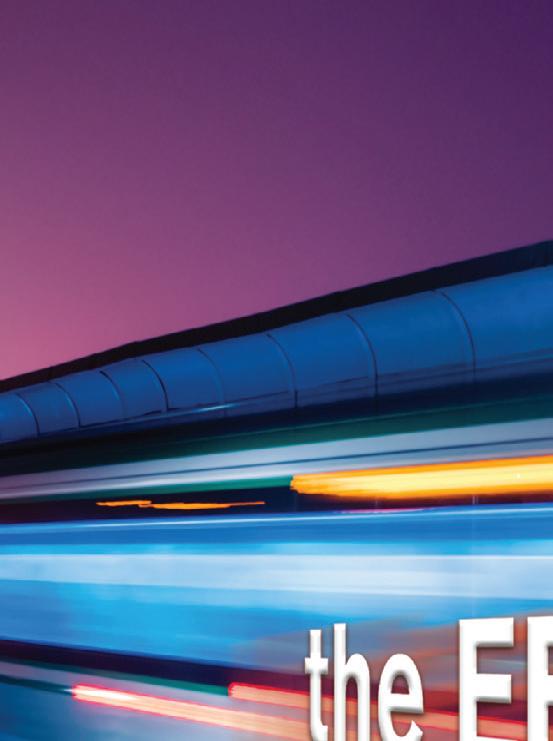

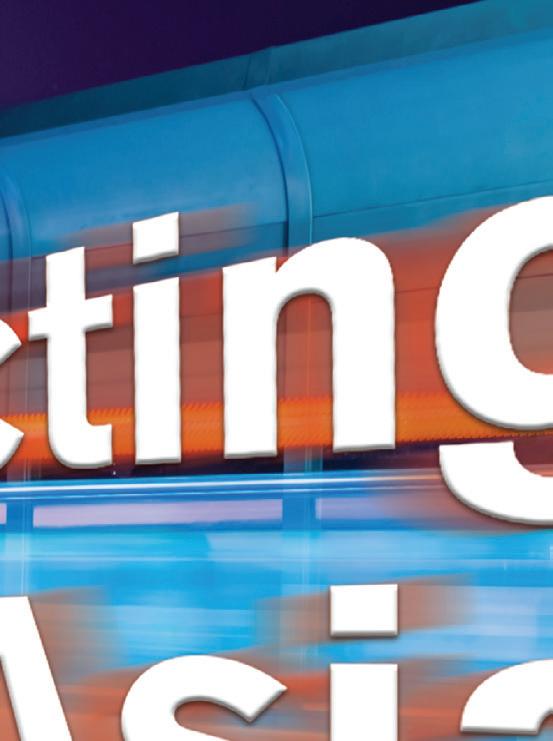




Greener manufacturing and transport
Entrance Matting Systems produces entrance mats from higher recycled content and sustainably and ethically sources materials
The first product EMS manufactured was the Colortread entrance matting system, which is still a popular choice with many customers; including recent projects with East Midland Railway. Colortread offers a solid aluminium interlocking entrance matting system with a choice of infill strips in a variety of materials from rubber to polypropylene as well as coloured scraper bars. This provides scope for branding, logos and regional colours. The London Underground EMS LU Multi-track section twelve entrance matting system was specifically designed to meet the requirements for the London Underground Ltd (LUL). LUL has the strictest health and safety requirements for entrance matting, especially in relation to fire and smoke emissions. In order to be on the LUL register you need to meet all of these.
The entrance matting system has a solid aluminium grid system, with debris channels to collect dirt and other debris. The aluminium is a minimum of 95 per cent recycled material. The infill strips are manufactured in the UK, using natural rubber and moulded with EMS’s exclusive multi-track design. The rubber infill material has been designed, scientifically tested and manufactured with the help of Dr. Marina Fernando at TARRC Rubber Consultants to produce a section twelve low smoke emission rubber that is highly durable, anti-slip and sustainable. This unique and exclusive multi-directional rubber is perfect for rail and underground station entrances as it is designed for heavy traffic at any angle



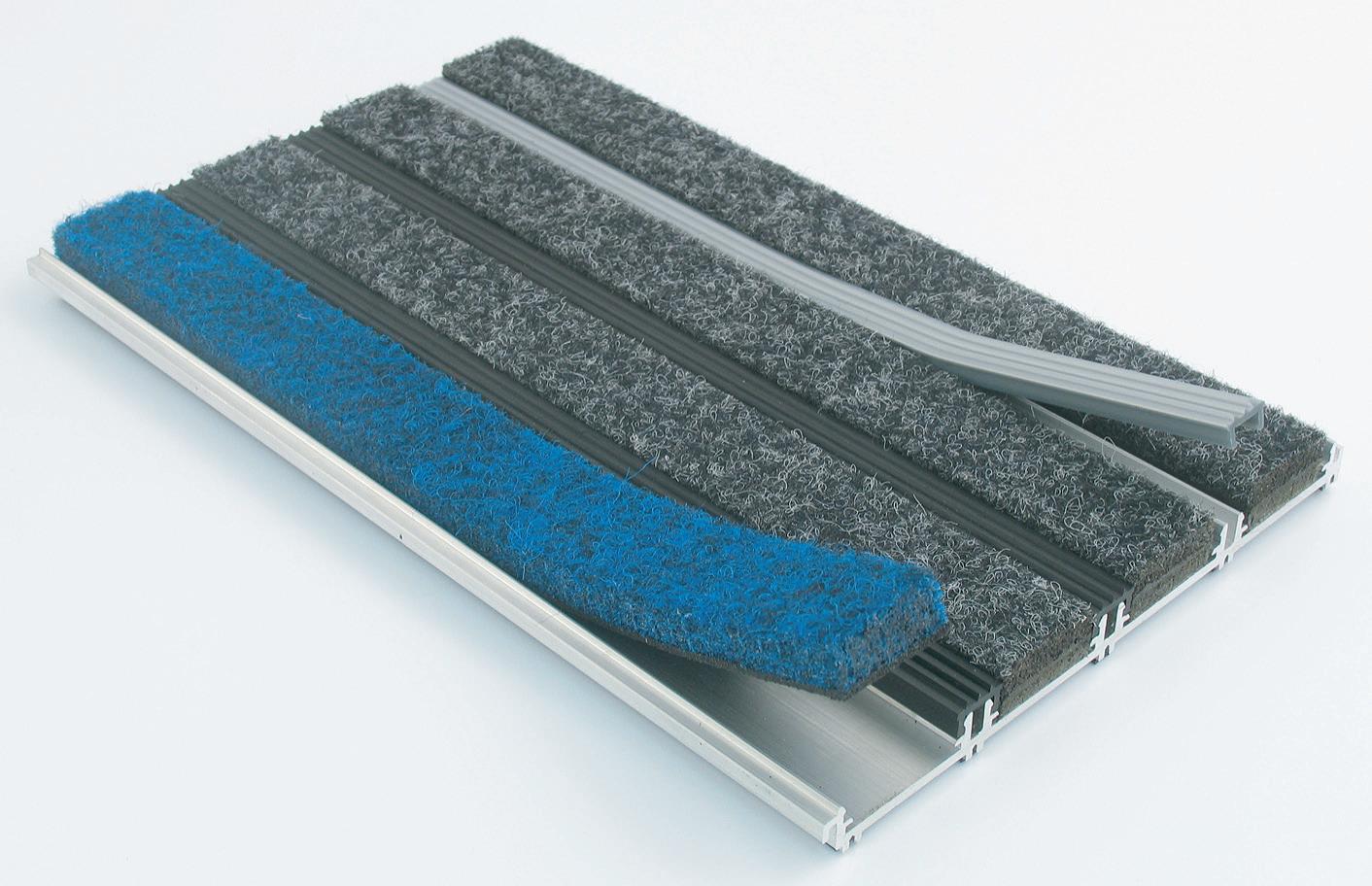

as well as wheelchair and pushchair use.
The same moulds have been successfully used with the non-section twelve multidirectional rubber infill; this offers similar infill material properties as above at a lower price for non-section twelve stations, other heavy duty entrance matting areas and public or private sectors.


Both systems have been successfully trialled and specified in numerous stations across the UK. EMS has worked with contractors to resolve particular station’s complications as well as adapting its products to suit specific drainage systems; for example, the EMS 80/20 drainage system, which is now in use at several LUL stations.
Not just rail – the LU section twelve and non-section twelve multi-track entrance matting systems are suitable for any high traffic areas, especially suited to other transport as well as other environmentally demanding applications, such as marine environments.
Specialised Transport Entrance Matting Systems Entrance Matting Systems (EMS) Ltd is a UK manufacturer of commercial aluminium grid entrance matting systems, specialising in sustainable and high specification products for demanding applications.
EMS is passionate about producing sustainable entrance matting across the whole of their product range. Working with other UK manufacturers to produce the highest quality entrance mats that have higher recycled content, sustainably and ethically sources materials. All of the EMS aluminium grid systems are easy to clean (without having to lift out or roll up) and maintain as well as having the additional bonus of replaceable infill material strips. Designed to make the entrance mats more economical and sustainable. EMS is currently working on a new project with a fully recycled infill material. It will be ready to test and trial later this year.
Tel: 01205 761757 Email: info@entrance-matting.com Visit: www.entrance-matting.com
Health and safety training goes 4D for HS2
Health and safety in construction is getting a much-needed boost courtesy of funding from HS2 via the UK’s innovation agency, Innovate UK
Anew customisable online training tool is now in development by specialists in cloud-based Building Information Modelling (BIM) and digital twins, 3D Repo, in collaboration with 4D consultancy, Freeform, and Balfour Beatty Vinci JV.
The new tool will replace generic training videos and presentations with live walkthroughs of site-specific 4D (construction sequencing) visualisations based on existing BIM models that can be understood in any language.
Generic safety training will be replaced by real-time, site-specific visualisations delivered via an easy-to-use cloud-based user interface. Health and safety aspects will be coordinated with the Health and Safety Executive (HSE) Discovering Safety Programme, to enhance opportunities for compliance and reusability across other contractors.
Funding for the new training system is provided through a Small Business Research Initiative (SBRI) innovation competition funded by High Speed Two (HS2) and managed by Innovate UK. The competition aims to deliver innovation that will drive project efficiencies and process for use during the design and construction phase of HS2.
Dr Jozef Dobos, CEO at 3D Repo said: ‘Inductions and onboarding in UK construction are usually delivered using generic PowerPoint slides, pre-recorded videos and printed questionnaires. Our new training solution will enable site personnel to quickly and easily generate engaging site-specific induction materials that are easy to comprehend and therefore reduce accidents and near-misses through better quality training.’
Dan Fawcett, Head of Innovation & Transformation at Balfour Beatty Vinci said: ‘Our number one priority is to be ‘Be Safe and Well’ when constructing HS2, and BBV’s work on 4D Constructability Reviews with 3D Repo to date is a great example of innovating to improve health and safety. Introducing further collaboration with Freeform and HSE to build on this work is yet another step forward in ensuring no injury, ill health or incident is caused by our work activities.’
James Bowles, Founder of Freeform, said: ‘4D models use graphical and nongraphical project information including time, resource, and logistics management to create more predictable, robust plans and sequences. With 3D Repo, we are developing a novel online tool which allows for simple planning and visualisation of intricate tasks to improve health and safety not only on HS2, but for the entire construction industry.’
Using the power of the cloud, the new training system will also provide centralised tracking of induction performance with full audit trail and reporting to measure effectiveness. Work on the new 4D health and safety tool began in March 2021 and follows on from a recent announcement about adoption of new SafetiBase 4D technology which allows workers to safely identify and resolve issues using immersive 360º screens.

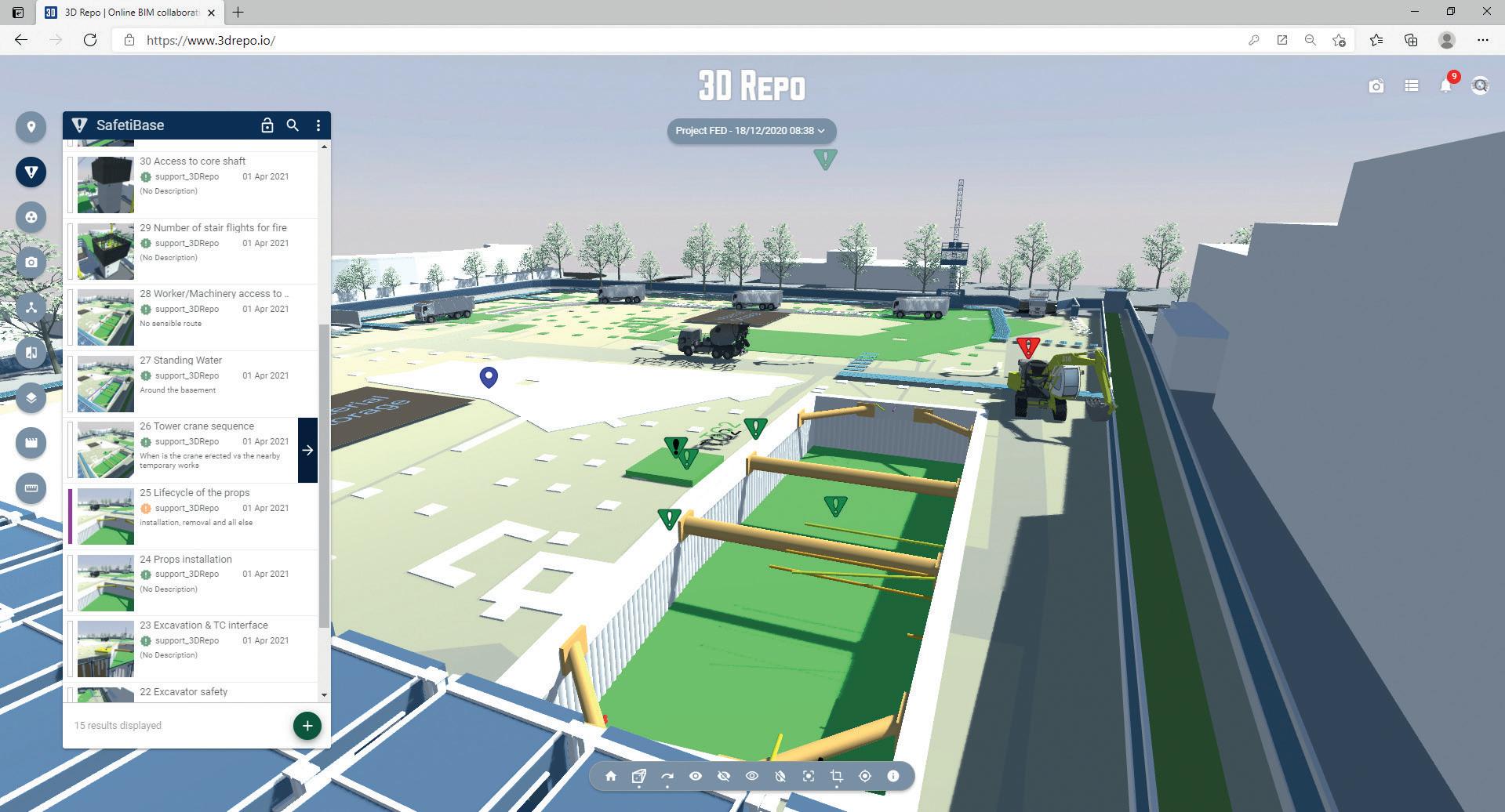
Tel: +44 (0)7383098005 Email: support@3drepo.com, sales@3drepo.com Visit: 3drepo.com
Peter Daly of global textile manufacturer Camira
As global textile manufacturer Camira approaches its 200-year anniversary of providing to the transport industry, we spoke with Peter Daly, Head of European Transport Sales, to learn about the company’s rich heritage, and the exciting plans it has for the future

So, where did Camira’s transport textile roots begin? How did you grow to become the global organisation you are today? Our heritage stretches all the way back to 1822, when a cloth manufacturer named John Holdsworth founded a worsted spinning mill named Holdsworth in Halifax - a town in the North of England, celebrated for its woollen textile heritage. Over the years, the company greatly expanded and built a renowned reputation for providing speciality cloths for railroads and shipping companies, supplying them to transport organisations across the world.
In the 1900s, Holdsworth solidified its expertise in the transport industry, becoming a founding member of the Moquette Manufacturers’ Association and symbolising the firm’s commitment to the iconic textile construction which remains a beloved staple in the Camira portfolio to this day. The company also began to concentrate on the export market, developing its presence across the globe and, by the 1990s, sales in North America formed approximately a fifth of the company’s turnover, in addition to significant growth being achieved in Continental Europe and Australasia.
This growth was complemented by significant investments in machinery and state-of-the-art equipment, making the Holdsworth factory one of the most modern and largest weaving units of its type in the world!
After six generations in the family, the Holdsworth business was sold in 2005 for real estate development of its historic mill complex. Two years later, in 2007, Camira purchased the Holdsworth brand name and assets – including the moquette looms on which our transport textile heritage is founded – and brought the historic firm into the Camira Group, ensuring its expertise and capabilities continued to play a valuable part in the transport industry.


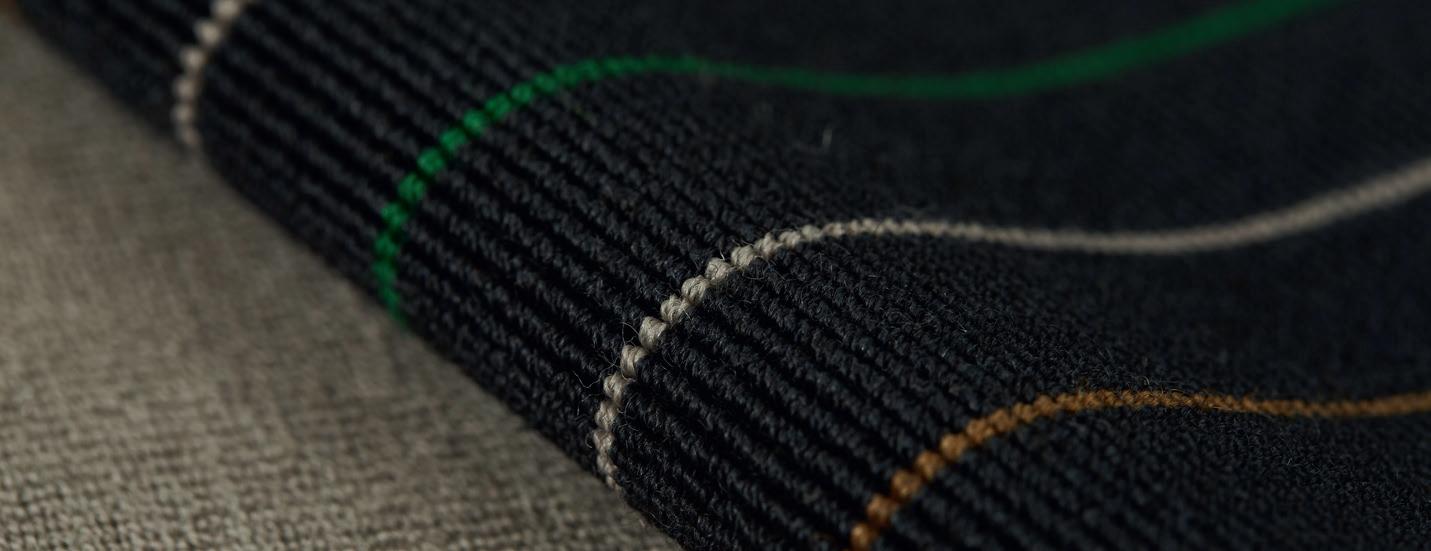
Could you tell us about some of Camira’s highlights from the last two hundred years? There must be a lot to choose from in such an extensive period!
Of course! There are so many key moments – from the construction of Holdsworth’s famous offices by Sir Charles Barry in the 1860s through to working with London Underground on the creation of their iconic moquettes in the 1900s (a partnership that remains as strong as ever today), and even the launch of our pioneering wire-woven capability, Hybrid, in 2019.
We’ve also worked on some really amazing projects over the years – including producing the fabric featured on the world-famous Orient Express, Deutsche Bahn’s innovative Ideas Train, and a brand new bespoke moquette set to feature on the upcoming Elizabeth Line.
The ongoing Coronavirus pandemic has obviously had a major impact on public transport, do you see rail interiors changing as a result?
Many people envisage that interiors will move towards ‘wipe clean’ seating – with hard plastic, vinyl and polyurethanes becoming the preferred choice, but we believe that there is a very bright future for natural materials to work alongside a variety of other complementary surfaces; and that’s certainly something we’re seeing in our own customer base.
There’s a large amount of research which indicates that the use of natural materials within interiors is incredibly beneficial for our wellbeing – particularly in light of the recent focus on indoor air quality and the emission of VOCs (Volatile Organic Compounds) which can be harmful to human health – and this is something that rail operators are really considering when designing their carriage spaces. With wool being nature’s ultra-intelligent fibre type, it is a naturally low emitter of VOCs, and actually improves indoor air quality. These in-built health properties, combined with its sustainable nature and the textural and visual appeal of a wool fabric, make it a truly timeless choice for rail interiors – as popular today as it was when we started back in 1822.
Finally, do you have any exciting plans in the pipeline that you can share with us?
Whilst we can’t give specifics just yet, our Design and Innovation teams are busy working on a number of exciting projects that we’re very much looking forward to sharing - so we are proud to say that the forward-thinking ethos, passionate commitment, and continuous development that defined the Holdsworth name for centuries remains alive and well in the Camira brand.
And, of course, our 200-year anniversary officially takes place next year, so preparations are very much underway for the big celebration.
Textiles for an exceptional rail experience
Designing and manufacturing fabrics which transform seats and spaces, provide an optimal passenger experience, and meet the highest of performance and safety standards, Camira is the ideal partner to create the perfect upholstery solution for your rail interior.
Explore what is possible at www.camirafabrics.com/rail
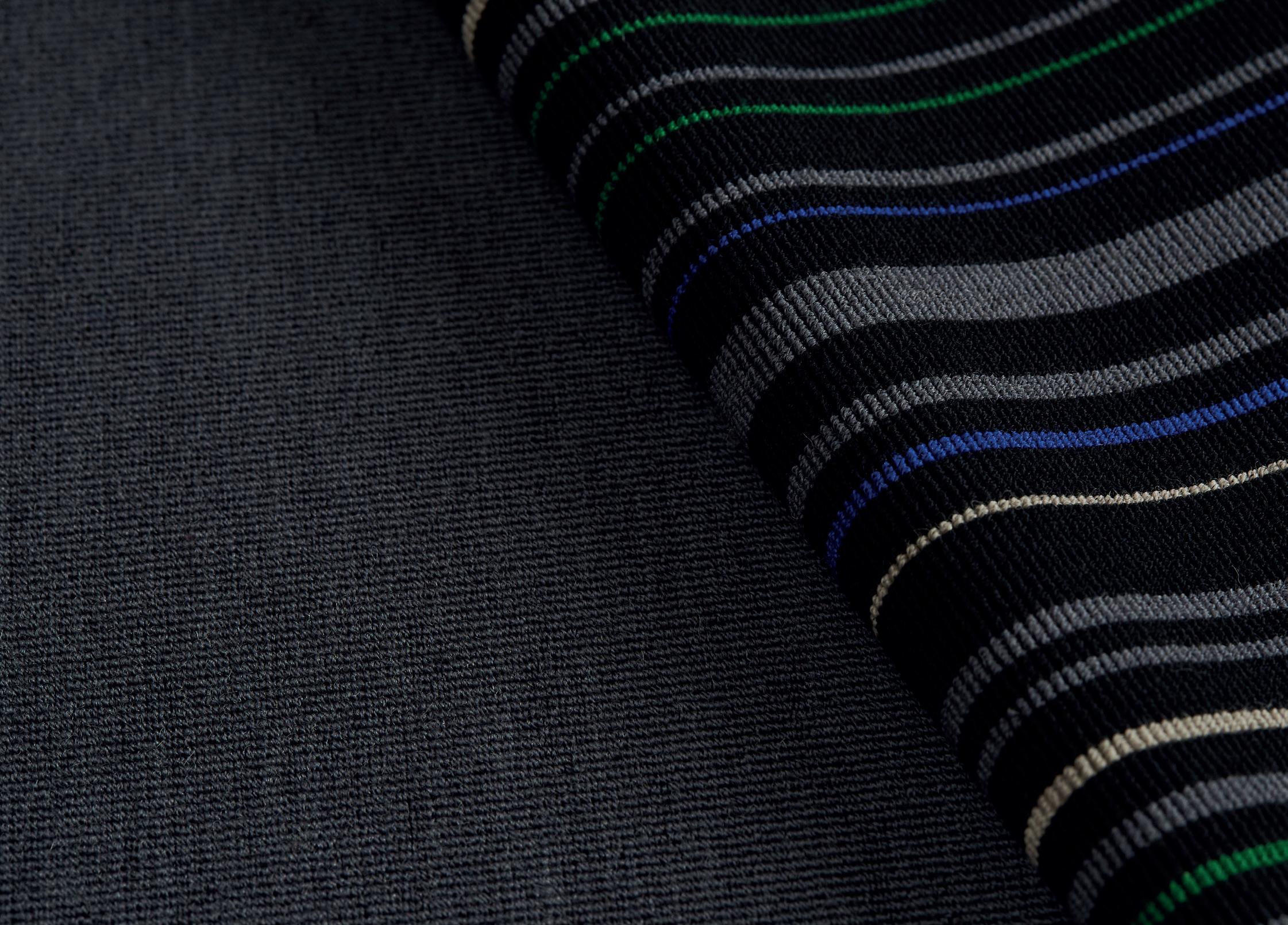





RIA Annual Conference 2021
4 – 5 November 2021, London Hilton Bankside
// 2-day Conference including 25+ national and international speakers // Unique networking opportunities to meet with key industry leaders // Programme combines keynote speeches, panel discussions and interview sessions // Best Conference at the Association Excellence Awards 2019
www.riagb.org.uk/ac2021
Latest scaffolding innovation from Layher brings new safe, fast and versatile rail opportunities
Layher Ltd, the world’s largest manufacturer of modular scaffolding, access and temporary protection equipment, is adding a new system to its range that will simplify and enhance façade scaffold installation across a range of sectors, including the rail industry. The company’s AGS system features a post and guardrail design which, while completely independent, can also interface directly with the wellestablished Layher Allround design. With the focus on the same key benefits of safety, speed and versatility, users involved in both rail new-build and maintenance operations are set to gain.
‘The AGS system comprises two-metre
standards, with integrated Layher rosette connectors to which a guardrail is attached’ explains Layher’s UK Managing Director, Sean Pike. ‘Once positioned, the assembly is elevated by hand from the secure lower level and fixed in place via innovative quick-release loading levers. Importantly, these are coloured red to enable a rapid visual check of an entire structure to be made from ground level.’
The AGS system standards provide the same loading capacity as their Allround stablemates and, with a choice of guardrail lengths of between 1.57 metres and 3.07 metres, installations can match the full range of Layher’s common bay widths. Advancing side protection can also be incorporated while a structure can feature both external and internal protection throughout.
‘As with so many of our recent developments, the AGS system uses lightweight materials, which not only aids the manual handling process but also, because of its dimensions, helps to optimise transportation and storage. Extensions can then be readily added, regardless of the existing structure’s layout’ continues Sean Pike. He points out that this is of particular note in the rail industry where both space limitations and possession time constraints have to be accommodated.
A key benefit of the range of Layher’s system designs is the interchangeability of specific components, and this latest development is no exception.
‘Bracing components, such as Allround Ledgers, or diagonals, as well as U-shaped transoms can be fitted in the normal way as a result of the AGS standard having rosettes that will line up at the decked level’ adds Sean Pike. ‘This enhances the system’s independence enabling the user to react flexibly to requirements that may arise on site. At the same time, all other Allround components, for example brackets, stairs and temporary bridging systems can become part of an AGS installation.’
Layher highlights the role played by continuous equipment innovation – much of which has been inspired by customer feedback – in its success over many years, and places the new AGS system in the same spotlight.
‘We are fully committed to optimising the safe and efficient use of scaffolding, access systems and temporary protection across all of the markets that we serve – with rail applications high on the list’ concludes Sean Pike. ‘The design characteristics and user benefits now available with the new Layher AGS system design will be fully recognised in this context by all our users.’


Tel: 01462 475100 Email: info@layher.co.uk Visit: www.layher.co.uk
Tony O’Donnell, Engineering Director at Mabey Hire, explores the value of employing intelligent monitoring solutions in conjunction with propping and jacking equipment when working to keep our rail bridges safe

The UK has over 30,000 rail bridges, tunnels and viaducts in its network. Maintaining and repairing these bridges, as well as responding quickly and efficiently to any emergencies, is vital to help keep them safe and open for rail traffic.
From spanning roads to rivers and valleys, bridges are an integral part of this country’s rail network. Their closure, whether due to structural repairs or an accidental bridge strike, can have a real impact on rail services, causing huge disruption to passengers. As such, any solution that can help to ensure the bridge is safe to remain open whilst repairs are carried out, or that can keep closures to a minimum following an emergency, is invaluable.
Temporary propping and jacking are one example of such a solution, used to provide structural support for everything from building façades to bridges, to even lifting a bridge off its support piers while work is carried out underneath. Structural monitoring is another, used to provide live, up-to-the minute data on the behaviour of structures and infrastructure, such as buildings, bridges, tunnels and earthworks, either before, during or after work has been carried out.
When propping, jacking and monitoring are used together, the value and benefits for asset managers and contractors can be huge.
Within the rail and highways sector, there is an increasing use of permanent monitoring on structures and other assets, minimising the reliance on visual inspection and human access to detect deterioration or damage. This intelligent, live data provides asset managers with an instant and accurate picture of the condition that the bridge is in, determining its maintenance and repair schedule.
Should the monitoring highlight that the bridge is in need of repairs, this same data can then also be used to feed into designing the appropriate temporary propping and jacking scheme. Likewise, in an emergency, applying structural monitoring to the bridge is perhaps one of the first steps to be undertaken, providing project teams with instant insight into the bridge’s condition and enabling them to take the necessary steps to making the bridge safe, fast.
With enhanced visibility of the behaviour of the bridge, engineering teams know exactly what they are designing for, resulting in a more efficient scheme design. What’s more, having access to such accurate information on the bridge’s loads, condition and structural stability also enables better value-engineering of the propping scheme, potentially helping to reduce the amount of steel required and cut costs.
In addition to informing the design of the propping and jacking scheme, monitoring can also be used in conjunction with the propping equipment to help ensure the structural integrity of the bridge. Given the significant disruption to rail users should a bridge have to be closed, monitoring solutions can be key in enabling a bridge to remain open while essential repairs are being carried out.
One of the many challenges when designing a propping and jacking scheme for a bridge, in comparison to a building, is that the load requirements can change, depending on the amount and weight of passenger and freight services using the bridge on any particular day. By applying structural monitoring technology, teams can be instantly alerted should the loads or forces fall outside of the set limits, enabling them to make the necessary alterations to the props. Here, structural monitoring can be an invaluable means of providing additional confidence and assurance in the propping scheme, as well as mitigating risk.
Pushing this integration between monitoring and propping further, there is even the potential for the hydraulic props on site and the monitoring software to be automatically and intelligently linked. Here, should a change in loading or deflection be detected, an alert can be triggered, causing the jack to automatically adjust and move to satisfy the new load requirement. It is perhaps this very integration and flow of data between the two disciplines that is one of the key benefits of working with a temporary works provider that possesses both propping and monitoring capabilities, enabling a speedier and more streamlined workflow, as well as minimising the complexities of managing multi-supplier projects.
With the widest range of temporary works equipment available, from structural and environmental monitoring solutions to propping and jacking, groundworks support, temporary bridging and site access solutions, and over 60 years’ experience, Mabey Hire has the skills and expertise needed to offer customers a total solution, helping to keep our country’s bridges safe and open for business.


Tel: 01924 460601 Email: info@mabeyhire.co.uk Visit: www.mabeyhire.co.uk
Specialist telecoms adviser for the rail industry

Analysys Mason advises policy makers, investors and network operators (telecoms and other critical national infrastructure such as transport and utilities). Our work in the rail industry includes:
• Developing strategies for rail network operators on operational telecoms network evolution • Providing commercial and technical assessment of rail telecoms infrastructure assets, including analysis of asset useful life and obsolescence • Advising investors on commercial opportunities in fibre and mobile markets, including rail infrastructure asset reuse
Global leaders in TMT management consulting
Analysys Mason is the world’s leading management consultancy focused on TMT, a critical enabler of economic, environmental and social transformation. We bring together unparalleled commercial and technical understanding to deliver bespoke consultancy on strategy, transaction support, transformation, regulation and policy, further strengthened by globally respected research. Our clients value our advice which combines deep domain knowledge with global reach and local insight into markets to help them achieve meaningful business results. We are committed to our clients, employees and communities – contributing to a world where technology delivers for all.
On reflection, optical bonding improves TFT displays
Relec Electronics offers an optical bonding service for TFT displays to combine design innovation with ease of access for users
TFT displays are popular because the proven technology can be integrated into a wide variety of installations, in industrial and commercial settings. They are used in transportation systems as well as in industrial settings where they information from equipment can be relayed, viewed and/ or controlled easily by the user.
TFT assemblies are typically made up of a touch panel or cover lens and the display, with a natural air gap between the two. When an external light source (natural sunlight or ambient lighting) enters the front of the assembly (either natural sunlight or ambient lighting), the light passes through the top layer (touch panel or cover lens) and then through the natural air gap refracting and reflecting the light through the different layers, which leads to distortion and glare, making the screen’s image distorted or difficult to view.
Applying a clear material within the air gap creates a single optical layer and prevents internal light refracting. This is called optical bonding and is available as a design service from Relec Electronics.
The optical layer has other benefits, besides improving readability. The absence of an air gap makes the unit strong with a high impact resistance. Optical bonding also prevents moisture ingress and the introduction of foreign materials within the optical stack to prevent fogging and to improve the backlight performance and contrast ratio.
Relec offers Optically Clear Resin (OCR) bonding and Optically Clear Adhesive (OCA) bonding.
OCR bonding involves a liquid siliconebased layer injected into the TFT’s air gap. This is done using a vacuum process to ensure the adhesive is evenly spread and without bubbles. The assembly is UV cured to set the silicone.
One of the main advantages of OCR bonding is that there is no restriction on thickness of the adhesive; it can be used with air gaps up to 1mm. The thicker the adhesive used, the higher impact resistance.
It also offers high transmittance capabilities, high protection levels against reflection and UV. OCA bonding uses an acrylic sheet with adhesive applied to both sides. This is laminated within the air gap to create a single optical layer.
While OCA bonding is a relatively simple and low-cost process, it is restricted to certain sheet thicknesses which are available on the market. Its transmittance rate and impact resistance are also less than OCR bonding. It does not protect against light reflection to the same degree as OCR bonding and the chances of yellowing due to UV exposure increase compared with OCR bonding. Relec Electronics Specialist Relec Electronics has a proud 40year history in the displays’ business. It is able to listen, advise and recommend the best products sourced from a wide range of display technologies. The company has supplied custom mono displays, standard mono displays and modules to many industries and types of customer.
The company’s range of TFT panels and touch panels, is combined with its dedicated customer service. Working closely with
specialist partners, Relec can provide the panel or monitor the customer needs and is happy to develop custom solutions for whatever the application, be it light industrial or heavily ruggedised for the harshest of environments. Relec’s standard TFT display products are available in a wide range of sizes, from small (1.77”) to 21.5”. They cover all industry standard resolutions, sizes and interfaces. Standard units are available with brightness levels exceeding 1500 cd/m².
In addition to supplying standard panels, Relec has the ability to offer a range of enhancements to improve the optical, mechanical and environmental performance of a display.
Since December 2020, Relec Electronics has been a UK subsidiary of Gresham Worldwide.

Light refraction and reflection can cause significant distortion and glare
The best bonding option for a particular installation needs careful consideration and should be based on a number of environmental and use-case factors. The process also has to be performed with precision and skill to avoid discolouration, or bubbles/ foreign material being introduced to the adhesive material. If the material is not applied evenly, it can result in clouding in parts of the display’s active area – known as the Mura Effect. Using an inappropriate material which does not match the composition of the TFT’s polariser can result in delamination of the optical bonding layer.
Relec Electronics has over 40 years of display experience and offers a range of engineering solutions to optimise the chosen display for a specific installation. The display specialist supports customers by fully understanding the application, environment, and budget for each project and works to supply optimised solutions. Tel: 01929 555700 Email: sales@relec.co.uk Visit: http://www.relec.co.uk

Perception – the only performance indicator that will matter

The Williams-Shapps Plan for Rail looks to not only be the pathway out of Covid but the route to a vastly different future for train operating companies (TOCs)
Rightly so, a coherent and quality customer experience continues to be at the centre of all plans with new incentives and penalties for service quality performance likely to be written into the national rail and passenger service contracts. TOCs are sure to be looking for solutions.
If TOCs want to be cost effective and avoid costly fines, they will need to level up their service quality regime on trains and at stations. Fast.
How does a TOCs service quality delivery impact on customer perception of the journey experience they receive? A mismatch between what customers expect and what they actually experience is bound to have a negative impact on their perceptions and trust in the operator.
Take a typical customer who is weary of using rail following the Covid-19 messaging about infection risk when using public transport but has been told trains have a rigorous cleaning regime to ensure they are Covid secure. What impact will there be on that customers perception when they are faced with a cracked tabletop throughout their journey, which has dirt traps with visible soiling? Does that say to the customer that the train has been rigorously cleaned?
Another example being etching and graffiti that is visible to customers throughout the journey that suggests anti-social behaviour is likely. Does this communicate to customers that rail is not a safe and welcoming environment for them? What does this say about the effectiveness of visible staff and CCTV in ensuring a safe and secure travel environment?
In January 2021, Diamond Rail Services launched their Front of House service, designed to fill the gap between train presentation and maintenance and complete tasks that fell through the established process net, such as paint, graffiti and etching repairs, seat cover changes and general smaller wear and tear issues which impact on train interior service quality, but are not always easy to resolve during normal maintenance schedules. With the Williams-Shapps plan announcement, Diamond Rail Services have further reacted and evolved this service to include auditing and reporting services and to include stations and customer experience too. This creates a really clean cycle and complete turnkey solution for service quality.
Diamond Rail Services are collaborating with mpro5 to maximise the opportunities to transition to a fully digital service quality management system. They have already proven their system at several TOC’s with their user friendly and easy to navigate app and this would be used by our auditors to complete service quality inspections. In addition, this app-based solution would allow the vast number of data points collected to feed into a structured rectification and long-term asset management program. The dashboard and outputs for rectifications and stakeholders is extremely engaging, user friendly and when used correctly, can bring multiple benefits to the train operator and their customers.
Diamond Front of House offers TOCs the opportunity to enhance processes by bringing this data to a single point of focus and enable the implementation of measurable improvements to overall service quality delivery. Apply this approach across a TOC, and suddenly service quality is totally taken care of for.
The service is completely customisable working alongside current
internal processes to fill any gaps or replacing these with a brandnew dedicated set of processes, recognising that lines of route and geographical locations can have different operational requirements and will differ on service quality performance. Diamond Rail Services would use the service quality data to then build the initial Front of House scope of work, and then review this in a data driven manner throughout the life of the service.
This way of working is already becoming reality in the rail sector. Several train companies are already a long way down the track towards connecting their departments and delivering a clean, safe, and passenger-focussed customer experience. Is your train company ready for the new developments? Or does your service quality regime still need work?

Jenny Dempsey is Business Development Manager at Diamond Rail Services
Tel: 07983043804 Email: Jenny.dempsey@diamondrail.co.uk Visit: www.diamondrail.co.uk

CrossCountry appoints Customer Director
Britain’s largest long-distance operator, CrossCountry, has appointed Colette Casey as Customer Director.

Vintage Trains Charitable Trust appoints two new Non-Executive Director Trustees
Vintage Trains Charitable Trust has strengthened its board of trustee directors with the appointment of two new nonexecutives having wide ranging experience in the transport industry and change management. Arabella Nairne and Audrey Ezekwesili have joined the charity, bringing skills that are highly relevant in the changing world of rail transport, customer service and community engagement.
Atkins – a member of the SNCLavalin Group – has appointed Alex Parsons as Advanced Signalling Development and Delivery director, a newly created role responsible for leading and further developing Atkins’ in-cab and wayside signalling delivery capability.


Acorn Rail appoints new Programme Director
Acorn Rail has appointed Colin Berry as Programme Director for Wales and Western Regions.










